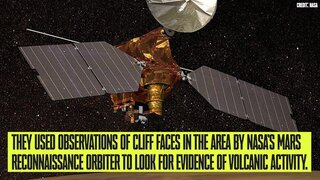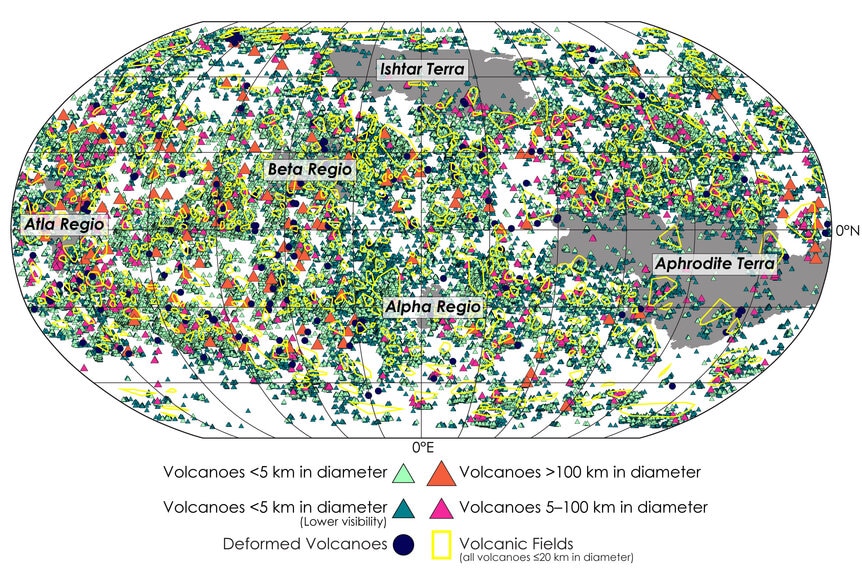Create a free profile to get unlimited access to exclusive videos, sweepstakes, and more!
Venus has a severe case of planetary acne with at least 85,000 volcanoes
It kind of feels like Venus is just showing off at this point.

Dante’s Peak, starring Pierce Brosnan and Linda Hamilton, plays out through the eyes of Roger Donaldson (Brosnan), a volcanologist for the United States Geological Survey (USGS). He warns of rising volcanic activity around the titular town of Dante’s Peak. The name of the fictional town — itself a reference to the first part of Dante Alighieri’s Divine Comedy, in which the poet Virgil journeys through the nine circles of Hell — might have been a clue to the residents.
Events begin innocuously enough, when a couple bathing in a hot spring is boiled alive like a freshly opened package of hot dogs. By the time the credits roll, the entire mountain has exploded and whatever is left of Dante’s Peak is buried beneath hot ash.
A whole lot of tragedy might have been avoided if anyone in a position of power had listened to Donaldson when he first warned of the danger. But no one could see the active volcano right in front of their eyes. On Earth, we at least have the benefit of seeing a volcano in front of us (even if we refuse to acknowledge it). But on a world like Venus, not even that is guaranteed. Surface data about Venus is difficult to come by because of its incredibly dense atmosphere. The air on Venus is about 90 times thicker than on Earth and made almost entirely of carbon dioxide. The bottom line is that Venus is enrobed in perpetual cloud cover, shielding its surface from view.
RELATED: Scientists find evidence of active volcano on Venus in 30-year-old Magellan images
Attempts to get below the clouds and see the surface up close have been met with overwhelming resistance by the planet. All of that atmospheric pressure, coupled with sweltering surface temperatures averaging 900 Fahrenheit (475 Celsius) make for a less than friendly environment. The record for longest-lived surface lander was set in 1981, when the then-Soviet Union’s Venera 13 probe touched down. It survived a little more than two hours. If scientists want to improve our understanding of what’s happening on (and underneath) the surface of Venus, they have to get creative.
Using the Synthetic Aperture Radar (SAR) data from NASA’s decades-old Magellan spacecraft, scientists recently succeeded in quantifying, categorizing, and cataloging volcanoes across the surface of Venus. The work was carried out by Rebecca Hahn, a graduate student at Washington University in St. Louis, and her colleague, Dr. Paul Byrne. The global Venus volcano results were published in the Journal of Geophysical Research: Planets. In total, they found more than 85,000 volcanoes, most of which were smaller than five kilometers in diameter at their base. As shocking as tens of thousands of volcanoes might sound, it’s possible that Earth has even more.
“Venus is the only Earth-sized body in our solar system, so it’s an interesting place. Here, we’re most familiar with volcanoes on the surface of the planet but there are tons on the seafloor that we just haven’t mapped yet. It’s certainly possible that the number of volcanoes on Earth is comparable to the number on Venus,” Hahn told SYFY WIRE.
In order to find out, we would need to get complete underwater topography (a science called bathymetry) for the entire globe. That’s harder to do here than it is on Venus because of Earth’s oceans. Counterintuitively, the data sets for Venus are better than for our own ocean floor, at least in this regard. Hahn continued, “We just have such a small data set, but it’s possible that there are hundreds of thousands of volcanoes on Earth.”
Having a global map of where the volcanoes are provides a new research tool for astronomers and could help to inform future missions. Knowing where the volcanoes are is a handy piece of information bot for remote research and for any future landing craft, especially in the face of recent news that Venus appears to be volcanically active today.
This project was completed before that news broke, so it’s unclear how many of the 85,000 identified volcanoes are active or to what degree. The recent discovery of an active volcano also used Magellan data and hinged on the changing shape of a volcanic vent between two pictures taken months apart. There are presently three approved missions heading to Venus in the next decade, and the data they return could provide similar opportunities to observe changes in Venus’ volcanic landscape.
RELATED: A new battery technology could be the key to robots that can survive on hellish Venus
“I am hopeful that with higher resolution imagery of the surface we’ll be able to detect possible change between each of those three missions, as well as the Magellan data,” Hahn said.
In the meantime, the map reveals some interesting planetary characteristics which, when compared to Earth, are truly alien. While the number of volcanoes on Venus might be similar to that of Earth, their distribution is wholly different.
“Venus doesn’t have plate tectonics like Earth does. There could be some other form of localized tectonics on Venus, but it’s not Earth-like. On Earth, a lot of volcanoes are associated with plate boundaries, but we don’t see any alignment of volcanoes in that way,” Hahn said.
Rather than volcanoes popping up in strings, like the volcanic island chains you might be familiar with on Earth, magma upwelling creates hotspots that don’t move, birthing families of volcanoes. While large volcanoes are rare, they tend to facilitate the formation of other, smaller volcanoes in their vicinity, which siphon some of the magma away from the larger volcano.
The new Venus volcano map might also serve as a literal map, leading to the sites of currently active volcanoes. Scientists could use the map to perform what’s known as kernel density analysis. In short, it’s a way of highlighting the areas with the most volcanoes, and on Earth we use it as an eruption indicator. The idea being that if there have been a lot of eruptions in one place before, there’s a decent chance there will be an eruption again. Coincidentally (or maybe not), the active volcano identified in the other study happened to be inside a high-percentage region of this map. If researchers had predicted active volcanism from their data, that’s the sort of place you might expect it to be. It’s possible that other high-percentage regions of the map could point to other active volcanoes on Venus.
Looking for a volcanic adventure that could only happen on Earth? Check out Dante’s Peak via Universal Digital, or Airplane vs. Volcano, streaming now on Peacock!



























